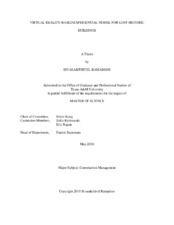| dc.description.abstract | Historic buildings have always been facing severe threats of destruction. Historic buildings are the physical links to our past, and help in forming and imprinting a cultural memory within us. However, when a building gets totally destroyed, the resources available to learn about the past are very limited. The archaeological relics, photographs, sketches, textural records, etc. fail to create a complete picture of the lost structure in our mind due to their unorganized nature and lack of possibility to explore in and around the building.
Virtual reality (VR) is an interactive technology that allows people to virtually walk inside built environments using digital tools, and enables us to experience them on a human scale. Virtual heritage (VH) applications have been a popular research area among the Architects, Archaeologists and Historians for more than two decades. Virtual heritage projects, excluding projects developed in the entertainment industry, are predominantly developed by researchers and academicians. These virtual heritage projects mainly focus on either the ‘Process’ (3D reconstruction mechanism) or the ‘Products’ (Virtual Reality systems) but do not consider the end-users, i.e. the ‘People’ going to use the system. Humans are cultural organisms and their cultural and demographical aspects differ from each other and hence the cultural interpretation, perception and reaction are subjective. Different cultural environment poses different meanings to different people. Hence, it is crucial to identify what end-users’ interests are in a virtual heritage environment in order to effectively educate about the past. This research attempts to investigate the experiences of users when a first-person Virtual Reality-based model of a lost building is presented to the visitors of the museum.
the entertainment industry, are predominantly developed by researchers and academicians. These virtual heritage projects mainly focus on either the ‘Process’ (3D reconstruction mechanism) or the ‘Products’ (Virtual Reality systems) but do not consider the end-users, i.e. the ‘People’ going to use it. Humans are cultural organisms and their cultural and demographical aspects differ from each other and hence the cultural interpretation, perception and reaction are subjective. Different cultural environment poses different meanings to different people. Hence, it is crucial to identify what end-users’ interests are in a virtual heritage environment in order to effectively educate about the past. This research attempts to investigate the experiences of users when a first-person Virtual Reality-based model of a lost building is presented to the visitors of the museum. | en |


